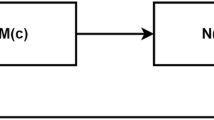Abstract
In this paper, we analyze the bit error rate (BER) performance of a chaotic cognitive radio (CCR) system, which enjoys benefits of high security provided by a chaotic communication system and high flexibility in non-contiguous spectrum access offered by an overlay cognitive radio (CR) system. In the proposed CCR system, the chaotic sequence is generated in the frequency domain instead of in the time domain, hence enabling non-contiguous spectrum access. We hereby derive the bit error rate expressions of CCR systems over additive white Gaussian noise (AWGN) channel and slow flat Rayleigh, Rician, and Nakagami fading channels. Specifically, we use the probability distribution of the chaotic map to evaluate the energy distribution of the transmitted signals over the identified non-continuous subcarrier bands, and then apply the definite integral representation of Q-function to calculate the bit error rate. The results from theoretical analysis and numerical simulations are compared, demonstrating an excellent agreement between the two approaches.







Similar content being viewed by others
References
Ren HP, Baptista MS, Grebogi C (2013) Wireless communication with chaos. Phys Rev Lett 110(18):184101
Stavroulakis P (2006) Chaos applications in telecommunications. CRC Press, London
Lau FCM, Tse CK (2003) Chaos-based digital communication systems. Springer, New York
Escribano FJ, Wagemakers A, Sanjuan MAF (2014) Chaos-based turbo systems in fading channels. IEEE Trans Circ Syst I 61(2):530–541
Dmitreiv AS, Hasler M, Panas AI, Zakharchenko KV (2003) Basic principles of direct chaotic communications. Nonlinear Phenom Compl Syst 6(1):408–511
Khodor N, Cances J, Meghdadi V, Quere R (2012) Performances of chaos-coded modulation concatenated with Alamouti’s space-time block code. Annales des Telecommun Ann Telecommun 67(1–2):27–55
Kaddoum G, Gagnon F (2013) Performance analysis of STBC-CSK communication system over slow fading channel. Signal Process 93(7):2055–2060
Simon H (2005) Cognitive radio: brain-empowered wireless communications. IEEE J Sel Areas Commun 23 (2):201–220
Saeedzarandi M., Azmi P, Simon H (2013) Cooperative multiband joint detection in cognitive radio networks using artificial immune system. Ann Telecommun 68(3–4):239–246
Sundersingh1 D, Chakarvarthy V, Wu Z (2012) Frequency domain processing based chaos communication for cognitive radio. Virginia Tech Wireless Symposium
Zhou R, Li X, Zhang J, Wu Z (2011) Software defined radio based frequency domain chaotic cognitive radio. IEEE SOCC Conference 259–264
Xia Y, Tse CK, Lau FCM (2004) Performance of differential chaos shift-keying digital communication systems over a multipath fading channel with delay spread. IEEE Trans Circ Syst II 51(12):680–684
Zhibo Z, Tong Z, Jinxiang W (2008) Performance of multiple-access DCSK communication over a multipath fading channel with delay spread. Circ Syst Sign Process 27(4):507–518
Long M, Chen Y, Peng F (2012) Bit error rate improvement for chaos shift keying chaotic communication systems. IET Commun 6(16):2639–2644
Kaddoum G, Gagnon F (2013) Performance analysis of STBC-CSK communication system over slow fading channel. Signal Proc 93(7):2055–2060
Kaddoum G, Charge P, Roviras D, Fournier-Prunaret D (2009) A methodology for bit error rate prediction in chaos-based communication systems. Circ Syst Sign Process 28(6):925–944
Kaddoum G, Gagnon F (2014) Lower bound on the bit- error rate of a decode-and-forward relay network under chaos shift keying communication system. IET Commun 8(2):227–232
Fang Y, Xu J, Wang L, Chen G (2013) Performance of MIMO relay DCSK-CD systems over Nakagami fading channels. IEEE Trans Circ Syst I Regular Papers 60(3):757–767
Kaddoum G, Richardson F, Gagnon F (2013) Design and analysis of a multi-carrier differential chaos shift keying communication system. IEEE Trans Commun 61(8):3281–3291
Kaddoum G, Shokraneh F (2015) Analog network coding for multi-user multi-carrier differential chaos shift keying communication system. IEEE Trans Wirel Commun 14(3):1492–1505
Kaddoum G, Giard P (2014) Analog network coding for multi-user spread-spectrum communication systems. IEEE Wirel Commun Netw Conf (WCNC):352–357
Yang D, Liu Z, Zhou J (2014) Chaos optimization algorithms based on chaotic maps with different probability distribution and search speed for global optimization. Commun Nonlinear Sci Numer Simul 19(4):1229–1246
Proakis JG (2001) Digital communications. McGraw-Hill, New York
Alouini M, Goldsmith AJ (1999) A unified approach for calculating error rates of linearly modulated signals over generalized fading channels. IEEE Trans Commun 47(9):1324–1334
Sandhu GS, Berber S (2009) Theoretical model, simulation results and performances of a secure chaos-based multiuser communication system. Int J Netw Secur 8(1):25–30
Fu H, Crussière M, Hélard M (2013) Spectral efficiency optimization in overlapping channels using TR-MISO systems. IEEE Wirel Commun Netw Conf:3770–3775
Acknowledgments
The funding supports from the Pilot Project (No. 20140101) and Normal Project (No. 20150207) of SYSU-CMU Shunde International Joint Research Institute, and the SYSU 100 Top Talents Program (No. 35000-1188134) are gratefully acknowledged.
Author information
Authors and Affiliations
Corresponding author
Rights and permissions
About this article
Cite this article
Zhang, L., Lu, H., Wu, Z. et al. Bit error rate analysis of chaotic cognitive radio system over slow fading channels. Ann. Telecommun. 70, 513–521 (2015). https://doi.org/10.1007/s12243-015-0472-9
Received:
Accepted:
Published:
Issue Date:
DOI: https://doi.org/10.1007/s12243-015-0472-9




